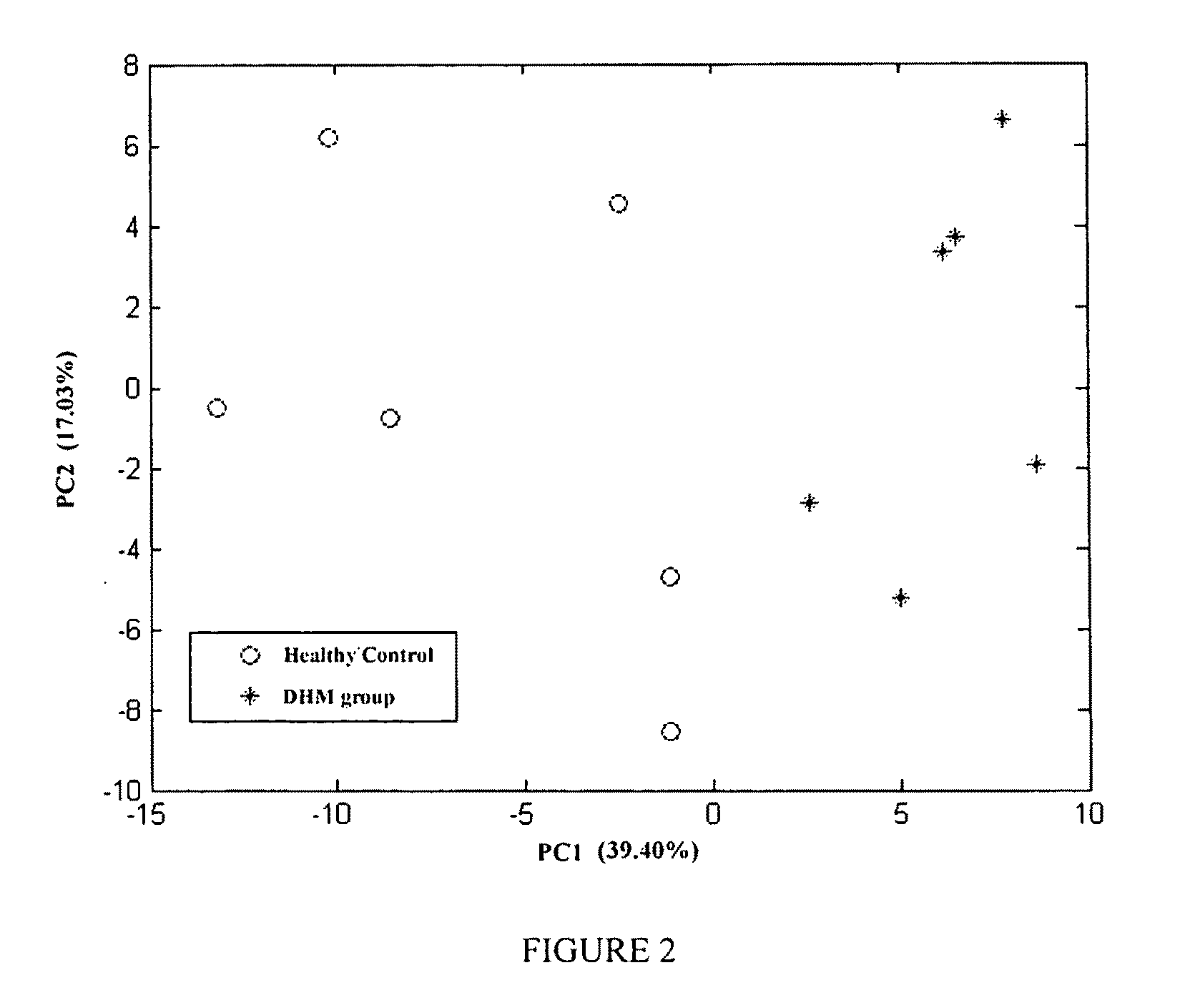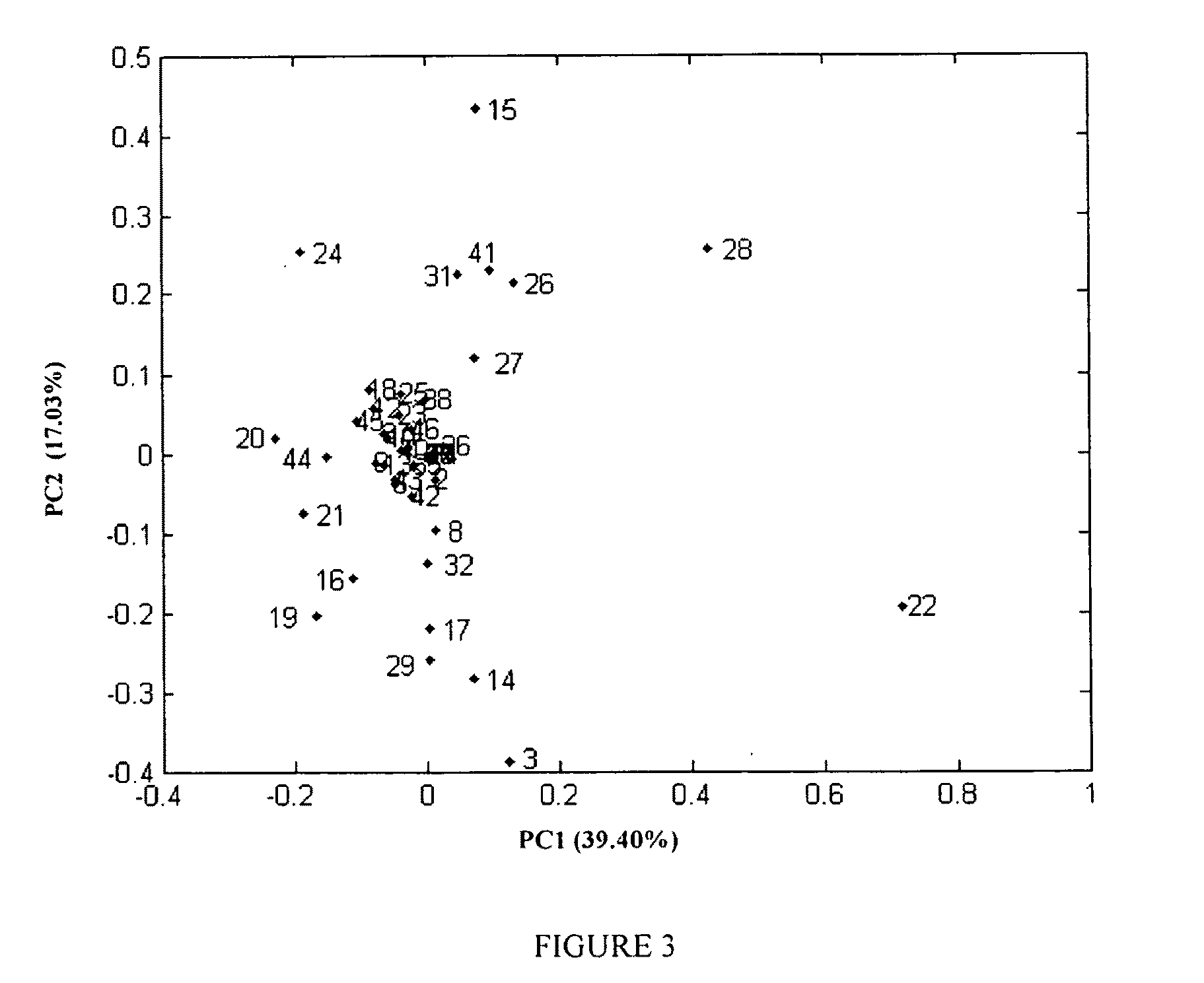Methods for detecting therapeutic effects of anti-cancer drugs
a technology drugs, which is applied in the field of methods for detecting the therapeutic effect of drugs, can solve the problems of inability to detect, monitor, and monitor the candidate method and agent for cancer chemoprevention and chemotherapy, and the cohort study is time-consuming and costly
- Summary
- Abstract
- Description
- Claims
- Application Information
AI Technical Summary
Benefits of technology
Problems solved by technology
Method used
Image
Examples
example 1
Effects of Traditional Chinese Medicine on Colorectal Cancer Chemoprevention in Rats
[0028]27 male Wistar rats (80˜100 grams) were purchased from SLAC Shanghai Laboratory Animals, Ltd. and housed in a special-pathogen-free (SPF) facility at Shanghai University of Traditional Chinese Medicine, where the temperature variation was between 20° C. and 25° C., the relative humidity was between 40% and 70%, the day / night cycle was 12 hours, and the cages were made of bottomless and stainless steel. Animal care and experimental procedures complied with “The Standards for Animal Environment and Procedure in the People's Republic of China”.
[0029]The rats were randomly divided into 4 groups: 6 for the healthy control group, 7 for the group harbored colorectal precancerous lesions, 7 for the group being treated with Coptis Chinensis (Huang Lian) and Evodia Rutaecarpa (Wu Zhu Yu) water extract (CEWE), a Traditional Chinese Medicine (TMC) herbal compound medicine, and 7 for the group being treated...
example 2
Identification of DNA Fingerprints in Fecal Microbial Total Genomic DNA
[0031]Fresh fecal samples were collected from all 4 groups of rats on the 9th week and stored in −20° C. freezer. Fecal microbial total genomic DNA was isolated using a commercially available kit (QIAGEN). PCR-based DNA amplification of this region enriches a highly variable region of the 16S rDNA gene that provides a good indication of phylogenetic affiliation of bacterial species (Muyzer et al., Profiling of Complex Microbial Populations by Denaturing Gradient Gel Electrophoresis Analysis of Polymerase Chain Reaction-Amplified Genes Coding for 16S rRNA, Applied and Environmental Microbiology, 59(3), 695-700, 1993). The sequences for PCR primers were adopt from Muyzer et al. The 25 μl PCR amplification reaction system comprises of: 0.5 μl of 25 μmol / L primer P2, 5′-ATTACCGCGGCTGCTGG-3, and P3: 5′-CGCCCGCCGCGCGCGGCGGGCGGGGCGGGGGCACGGGGGGCCTAC GGGAGGCAGCAG-3′, 2 μl of 2.5 μmol / L dNTPs, 20 ng of template DNA, 0.625...
example 3
Identification of Bacterial Species Represented by the Two DGGE Bands
[0037]Band excision. The two predominant bands, v3-22 and v3-28, in the DGGE gel were excised by using a sterile blade, sliced in fine pieces, suspended in 100 μl of distilled H2O2 in a 1.5 ml Eppendorf tube, and store at 4° C. for 16 hours.
[0038]Cloning. The cloning strategy starts with PCR amplification of an excised band by using the same PCR reaction system and cycling steps for DGGE analysis. PCR products were purified by using 2% agarose gel electrophoresis, the band with an expected size was excised, DNA fragments were extracted by using a gel recovering kit (Axygen, USA), purified DNA was suspended in 100 μl of distilled H2O2, and its DNA concentration was determined. The agarose gel-purified DNA fragments were ligated into a cloning vector. The ligation reaction consisted of 5 μl of 2× ligation buffer, 1 μl of pGEM-T easy vector (50 ng / μl)(Promega), 10˜20 ng of DNA fragments / inserts, and 1 μl of T4 DNA lig...
PUM
| Property | Measurement | Unit |
|---|---|---|
| Temperature | aaaaa | aaaaa |
| Temperature | aaaaa | aaaaa |
| Temperature | aaaaa | aaaaa |
Abstract
Description
Claims
Application Information
 Login to View More
Login to View More - R&D
- Intellectual Property
- Life Sciences
- Materials
- Tech Scout
- Unparalleled Data Quality
- Higher Quality Content
- 60% Fewer Hallucinations
Browse by: Latest US Patents, China's latest patents, Technical Efficacy Thesaurus, Application Domain, Technology Topic, Popular Technical Reports.
© 2025 PatSnap. All rights reserved.Legal|Privacy policy|Modern Slavery Act Transparency Statement|Sitemap|About US| Contact US: help@patsnap.com



